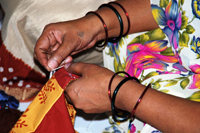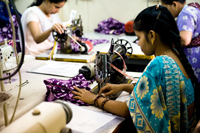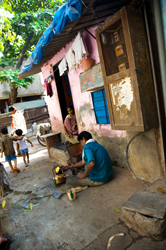
Huantian Cao
Associate Professor,
Fashion and
Apparel Studies,
University of Delaware
Huantian Cao is an associate professor in the Department of Fashion and Apparel Studies at the University of Delaware. His research interests include textile science, protective clothing, and sustainable apparel design and production. His research has been funded by the National Science Foundation, the U.S. Environmental Protection Agency, and the Oklahoma Center for the Advancement of Science and Technology.
Due to the large quantity of products manufactured, used, and disposed of, the textile and apparel industry has a big environmental impact in every phase of product life cycle. How do we make the industry more sustainable? Anastas and Zimmermann developed 12 principles of green engineering to provide a framework for scientists and engineers to achieve sustainability when designing new materials, products, processes, and systems [1]. Here are some thoughts on how the textile and apparel industry may apply these 12 principles for its own sustainable development.
Principle 1: Designers need to strive to ensure that all material and energy inputs and outputs are as inherently nonhazardous as possible. Currently, the textile industry uses many hazardous chemicals in fiber production, dyeing and finishing, leather tanning, and other processes. The American Apparel & Footwear Association’s (AAFA) Environmental Task Force has created a Restricted Substances List (RSL) to provide companies with information on regulations and laws that restrict or ban certain chemicals and substances in textile products. New processes and alternative chemicals should be developed. This will provide research and development opportunities for the textile and chemical industries.
Principle 2: It is better to prevent waste than to treat or clean up waste after it is formed. William McDonough and Michael Braungart have introduced a “cradle to cradle” design model [2]. Apparel designers can apply the concept of “waste = food” in this cradle to cradle model to reduce and eventually remove waste in the design phase. In the cradle to cradle model, there are two types of materials: “biological nutrients” that will easily reenter the water or soil through composting without depositing synthetic materials and toxins, and “technical nutrients” that will continuously circulate as pure and valuable materials within closed-loop industrial cycles. Examples of the application of the cradle to cradle concept in textile products include ramie/wool upholstery fabric developed by DesignTex using safe dyes (biological nutrients) and EcoWorx™ carpet tile produced by Shaw Industries (technical nutrients).
Principle 3: Separation and purification operations should be designed to minimize energy consumption and materials use. This “design for separation” principle is similar to “design for disassembly” in the cradle to cradle model that facilitates material recovery, reuse, and recycling. Apparel products use different fibers and materials in the outer shell, lining, and other components such as threads, zippers, and buttons. However, a mixture of biological and technical nutrients cannot be either composted or recycled. Apparel designers can use this principle to ensure that different materials can be easily separated after use. Students and faculty advisors at Oklahoma State University and Illinois State University have applied the design for disassembly concept to develop two men’s jacket prototypes, so that the biological and technical components in the jackets can be easily separated for composting and recycling. [3, 4]
Principle 4: Products, processes, and systems should be designed to maximize mass, energy, space, and time efficiency. In addition to reducing environmental impact, eco-efficiency will help companies save costs in the long term. Therefore, companies are willing to invest in new technologies that improve efficiency. One example of such technology is TUKAtrack™ developed by Tukatech, Inc. TUKAtrack™ is a Radio Frequency Identification (RFID) bundle tracking software that provides all the information (e.g., style, cut number, customer, production line, and sewing machine operator) needed in the sewing room. This technology can make production planning more efficient.
Principle 5: Products, processes, and systems should be “output pulled” rather than “input pushed” through the use of energy and materials. Apparel production should be driven by consumers' needs. The apparel industry can use just-in-time manufacturing to match consumer demand exactly for timeliness, quality, and quantity. This reduces waste and helps avoid big retail markdowns due to overproduction.
Principle 6: Embedded entropy and complexity must be viewed as an investment when making design choices that affect recycling, reuse, or beneficial disposition. In this principle, high-complexity components should be reused, while low-complexity components should be recycled or beneficially disposed of (composted). In apparel products, some textiles such as wool and leather fabrics and other components such as zippers and buttons can be considered high-complexity due to their high value and should be reused. Some textiles such as cotton and polyester fabrics and threads can be considered low-complexity and should be recycled (polyester) or composted (cotton).
Principle 7: Targeted durability, not immortality, should be a design goal. This principle can be applied in the packaging of apparel products. The packaging materials should be durable before consumers purchase the product. After purchasing, the packaging materials should be easily degraded and composted.
Principle 8: Design for unnecessary capacity or capability solutions (e.g., “one size fits all”) should be considered a design flaw. Due to the globalization of apparel production and consumption, same apparel products are sold and used regardless of local conditions. Some high-tech products such as sportswear and sport shoes may have functions that consumers may never realize or use. Compared with other industries, the textile and apparel industry does not make an effort to solve the over-design or over-engineering problem. This may also provide research and development opportunities.
Principle 9: Material diversity in multicomponent products should be minimized to promote disassembly and value retention. A blend of cotton and polyester fibers in fabric cannot be composted or recycled. Therefore, if possible, apparel designers should avoid using fiber blends to make recycling easier. Moreover, threads, buttons, and other components used on fabrics made from natural fibers should also be biodegradable materials, and components used on fabrics made from synthetic fibers should be made from the same polymer. For instance, cotton threads and natural buttons can be used on cotton or wool fabrics, while polyester threads and polyester buttons can be used on polyester fabric [3, 4]. The minimized material diversity will make disassembly, composting, and recycling easier.
Principle 10: Design of products, processes, and systems must include integration and interconnectivity with available energy and materials flows. Using locally available materials in apparel production can reduce the carbon footprint related to sourcing and transportation. For instance, cotton fabric manufacturers should be located in the areas producing cotton fibers. Apparel designers have also conducted pilot projects to use locally available materials. One example is Kelly Cobb’s 100-mile suit that sources all materials and production within a 100-mile radius of its intended use [5].
Principle 11: Products, processes, and systems should be designed for performance in a commercial "afterlife." Americans on average throw away 68 pounds of clothing per person per year [6]. Similarly, an average consumer in the UK sends 30 kg of clothing and textiles to landfills each year [7]. The nature of fashion is change. Many times, consumers discard usable clothing due to changes in style, trend, or size. To reduce waste, apparel designers should incorporate commercial “afterlife” into the initial design, so valuable components can be recovered and reused. Some design strategies such as modular design and adaptable design can be applied, which will also provide research and development opportunities for the apparel industry.
Principle 12: Material and energy inputs should be renewable rather than depleting. Renewable resources that can be explored by the apparel industry include bio-based fibers such as DuPont Sorona® and recycled synthetic fibers such as Teijin Eco Circle™ polyester. Renewable energy sources can also be sought out and used by apparel manufacturers and retailers.
References

Pushpika Freitas began her career by founding and directing the Leprosy Rehabilitation Center in Mumbai, India. She later founded SHARE (Support the Handicapped’s Rehabilitation Effort), a nonprofit organization in Mumbai, because of her passion for empowering women. SHARE was the beginning of the first cooperative of women artisans in Mumbai. SHARE currently works with 14 cooperatives. In 1986 Freitas founded MarketPlace: Handwork of India, in Evanston, Illinois, to create markets and promotional campaigns to support fair-trade products made by artisans in India. MarketPlace and SHARE have a common goal to provide women with opportunities to earn a living. By planning and controlling every aspect of production, the women learn basic skills that they can apply to other aspects of their lives, enabling them to be active members of their communities, take initiative in their children’s schools and other organizations, and participate in community decision making. The organization's innovative programs, such as Global Dialog, connect artisans with consumers and provide a platform for the artisans to communicate, discover, and act.
MarketPlace: Handwork of India was born from the needs, abilities, and requirements of poor women in Mumbai, India. From its very inception, the company was what might now be labeled “producer-driven,” as founders Pushpika Freitas and Lalita Monteiro worked with the women to find solutions that worked for them. They did not start with any academic viewpoint on development or even a conviction that they knew what was best for these women. Rather, they learned by doing, by trial-and-error, and by listening to what the women wanted. For example, since the women often had small children at home, tasks were devised that could be completed at home. Also, because they did not have sewing machines, they learned to do hand embroidery. Thus MarketPlace has always been a partnership of equals.


The enterprise has grown tremendously over 30 years, from three women hand-sewing patchwork that was sold in informal home sales to today’s network of 14 artisan-run collectives representing 480 women that produce high-quality clothing and accessories sold through a professional catalog and stores. Yet the essence of the relationship, the partnership, has not changed. MarketPlace’s function is to provide information about market trends, consumer research, potential opportunities, sales analysis, and marketing assistance to the artisans. The artisans are directly involved in all aspects of daily operations, including planning production, management, and quality control. Women in each cooperative make their own decisions concerning such things as profit sharing and social programs. The slogan “Dignity not Charity” was coined to represent the fact that this is not a charity. There are no handouts here, but rather women building and running successful and ethical businesses.
The authenticity of a partnership is also at the heart of the meaning of "fair trade." Fair trade is an idea and an ideal, which decades ago was conceived of as a way to make international trade more fair and just, in spite of the great inequalities of power and wealth that exist in the world. A trading partnership based on fair-trade principles is characterized by dialogue, transparency, and respect. It advances responsible and sustainable development by providing better, nonexploitative trading conditions to marginalized producers and workers. The principles of the World Fair Trade Organization attempt to codify the important features of the partnership.
1. |
Creating opportunities for economically disadvantaged producers. |
2. |
Working with transparency and accountability. |
3. |
Investing in capacity building. |
4. |
Promoting fair trade. |
5. |
Paying a fair price. |
6. |
Enforcing gender equality. |
7. |
Ensuring that working conditions are safe and healthy. |
8. |
Overseeing restrictions on child labor. |
9. |
Engaging in environmentally responsible practices. |
10. |
Establishing long-term and responsible trade relations. |
MarketPlace embodies these principles through the creation of strong, independent artisan cooperatives that incorporate democratic decision making and opportunities for the artisans to progress in skill and responsibility.
This partnership also includes a third party: the consumer. Fair-trade organizations are supported by consumers who have become more conscious of the power wielded by the people who buy goods and the potential damage this can cause to the producers, their cultures, and their communities. “Ethical consumers” want to be sure that their purchases do not support practices that are abusive to the producers or the environment. Fair-trade organizations can provide customers with reliable information concerning the conditions under which their products were made, bought, and marketed.
Unfortunately, the term “fair trade” has become a marketing tool for some companies that may not meet even the most lenient standards. In jumping on the fair-trade bandwagon by using this term or language that implies that they “trade fairly,” these companies hope to add to their market without changing their practices. Systems of certification have been established so that consumers do not have to rely on possibly self-serving claims but can turn to an objective third party to evaluate how well a company has met the criteria of real fair trade. It is also important to make it as easy as possible for people to recognize and buy authentic fair-trade goods. MarketPlace is accredited by the World Fair Trade Organization, which monitors whether companies are fulfilling their commitment to all the principles of fair trade.

For MarketPlace, the trading relationship is paramount, but it is just the first step. Fair trade is about improving lives as well as livelihoods. We recognize that economic development does not take place in a vacuum. The women in the artisan collectives must overcome a number of obstacles, including lack of education and training, lack of family support, and lack of resources. They often must fight against social norms that are inhibiting their actions and limiting their dreams. Many need to develop self-esteem and self-confidence. The MarketPlace programs in India incorporate a wide variety of courses, workshops, and discussions aimed at supporting these women’s success. All of these programs are designed and developed in collaboration with the artisans.
 Through these programs the women learn new skills and responsibilities, and they learn to express themselves and improve their lives. Most of these women are mothers, and helping their children is a high priority. The Armaan Club was established to provide their children with a number of enrichment and educational opportunities designed to help them stay in school, do well, and make smart choices in their lives. Fair trade is also about improving communities. The artisans have taken the organizational and leadership skills that they use in their businesses into their neighborhoods to work for improvements. Improving access to clean water and arranging regular garbage collection are just some of the projects they have taken on. In addition, they have created presentations on health and sanitation topics and lobbied for improved health care facilities. They have tackled problems such as alcoholism and abuse, forming chapters of Alcoholics Anonymous and Al-Anon.
Through these programs the women learn new skills and responsibilities, and they learn to express themselves and improve their lives. Most of these women are mothers, and helping their children is a high priority. The Armaan Club was established to provide their children with a number of enrichment and educational opportunities designed to help them stay in school, do well, and make smart choices in their lives. Fair trade is also about improving communities. The artisans have taken the organizational and leadership skills that they use in their businesses into their neighborhoods to work for improvements. Improving access to clean water and arranging regular garbage collection are just some of the projects they have taken on. In addition, they have created presentations on health and sanitation topics and lobbied for improved health care facilities. They have tackled problems such as alcoholism and abuse, forming chapters of Alcoholics Anonymous and Al-Anon.
Fair trade is about so much more than paying artisans or farmers a fair price. It is a partnership which aims to bring about sustainable development through the creation of a new way of doing business — a course of action based on respect, ethics, and concern for the future. MarketPlace and the independent collectives have together developed a means to manage the consequences of international trade, turning it into an opportunity to build new lives for the artisans and their children.

Richa Mittal is the Project Coordinator at the Fair Labor Association. She joined the FLA in June 2003 after completing a master’s degree in public health at the University of Michigan, Ann Arbor. For two years she was actively involved in managing a health program for garment workers in Bangladesh through Michigan International Development and has written about the existing labor health issues. She relocated to her native India in 2004 as the FLA Regional Manager for South Asia and managed its activities in India, Pakistan, Bangladesh, and Sri Lanka for four years. In the field, she developed the agriculture monitoring program for the FLA. Recently, she undertook the responsibility of managing FLA projects globally and is now based in FLA's Geneva office. Richa also has a master’s degree in human ecology from the University of Delhi.
India ranks second to China as the world’s largest garment manufacturer. It established itself as the world’s number one cotton yarn producer in 2008. The Indian garment industry plays a pivotal role in the Indian economy as it forms 6 percent of the gross domestic product (GDP) and contributes to about 12 percent of foreign exchange. It is a trillion-rupee industry (1 USD = INR 50) with 33 percent of knits and 20 percent of woven garments meant for export. Overall 25 percent of the produced garments are exported. It has over 100,000 production facilities. Fabric constitutes 65–70 percent of the cost of production, with labor making up a further 15 percent, and the remaining costs are for overhead and manufacturers’ profits. The garment industry is the second largest employer in India. With over 6 million workers employed, it is a major sector of focus for stakeholders in the area of labor standards and labor rights.
The worldwide economic recession of 2008–09 has severely hit the Indian garment industry. Since it took off in the 1970s, the garment industry witnessed an annual growth of 15–20 percent in the Multi Fibre Arrangement (MFA) quota days, to an unprecedented growth of over 30 percent immediately after the abolishment of quotas in 1995. However, there was less than 10 percent growth in 2008, and the industry fears it will have negative growth in 2009–10. This recession threatens worker lay-offs, possible deterioration in workplace conditions, and nonpayment of wages. There are several reports of factory closures and mass worker retrenchment in the industry. Some estimate that about one million people in the garment industry may have lost their jobs between July 2008 and March 2009.
The Indian Industrial Disputes Act of 1947 provides strict guidelines for worker lay-offs and retrenchment. In spite of the legal obligations, workers are continually being sacked without proper procedures. This has led to a surge in lawsuits against employers in the local labor courts. These, however, cannot be handled in a timely manner, simply due to shortages of resources in the courts. The workers, on the other hand, cannot wait for a court decision to get their dues. With their meager salary of approximately $60 per month, there are hardly any savings, and the workers must move on to find new jobs as casual or daily workers. There also is an increase in home-based work, illegally contracted out by factories. One of the root causes for this trend is lack of proper integration of effective human resource management practices with existing compliance work in factories.
Ninety-nine percent of the factories that I have visited in India over the past five years have two management positions created, one for an HR manager and the other for a compliance officer. In most cases these two persons hardly interact with each other on matters regarding workers and often contradict each other. This leads to conflicting systems in factories and, thereby, labor standards violations. In this gloomy scenario, the only optimism that the workers have is through interventions spearheaded by multinational companies (MNCs) sourcing from factories, civil society organizations (CSOs), multi-stakeholder initiatives (MSIs), and worker organizations that can represent workers’ interests.
The MNCs are increasingly seen as the makers of soft law, and the CSOs and MSIs are seen as guardians of those laws. A role reversal is taking place simultaneously wherein the companies and MSIs are evolving as capacity builders and trainers to suppliers and workers as opposed to auditors policing workplace compliance. For example, the Fair Labor Association (FLA), an MSI that is actively involved in improving working conditions in the garment industry worldwide, is mounting capacity-building programs to mitigate the effects of global recession. In India specifically, the FLA started creating awareness of the need and benefits of having social dialogue in factories for the promotion of responsible representation of workers and employers. The idea is for suppliers to utilize this lean period in the time of recession to install management systems that are developed together by workers and management. This will lead to enhanced trust among employers and workers, thereby creating a greater understanding of existing situations and leading to good-faith efforts to resolve issues. The FLA has also launched a series of online training programs for middle-level management on retrenchment, grievance handling, communication, consultation and negotiation, and good practices for hiring, discipline, and termination. Some MNCs are pitching in by agreeing to absorb the costs of these initiatives and substituting audits for capacity-building efforts. More companies need to follow suit instead of cutting and running to cheaper destinations.
A select few local suppliers are also driving similar initiatives in their factories. Shahi Exports Private Limited (SEPL), which has a total of 20 units in Bangalore, Tirupur, and Faridabad, is one of those. They have a robust HR department that doubles as the compliance department. Any new order placed in the factory has to obtain buy-in from the HR department, which calculates the factories' production capacities, numbers of workers, and types of skill sets needed to produce a new style. Every worker and supervisor must go through mandatory training before they are put on the job. The cost of training and time is borne by the factory. In my interviews, I have come across workers who have been employed at SEPL for over 15 years, are on a career path, and have been promoted from seamstresses to production managers. It is one of the few factories that has not been adversely affected by global recession and is still profitable.
A series of coherent and collective efforts from each constituency is needed in order to overcome the worst financial recession of recent times. More effort is needed from the Indian government, which so far has been silent about these layoffs. Without political intervention and will, the individual efforts can only make a difference in select factories.